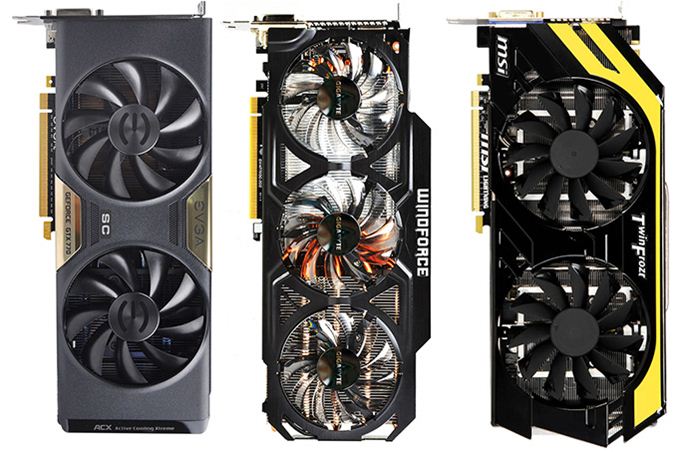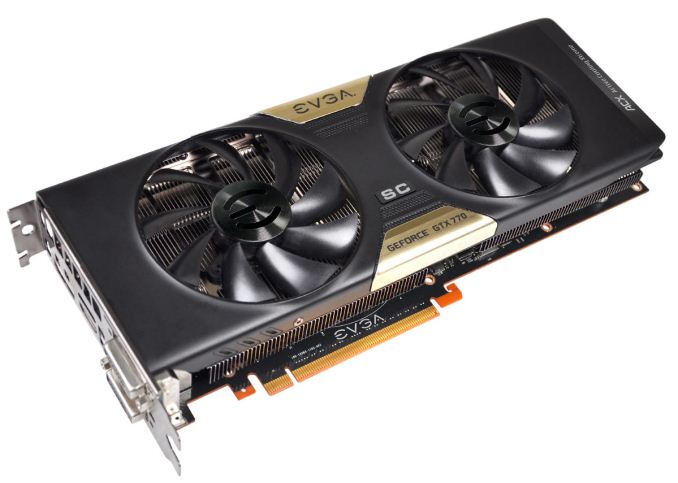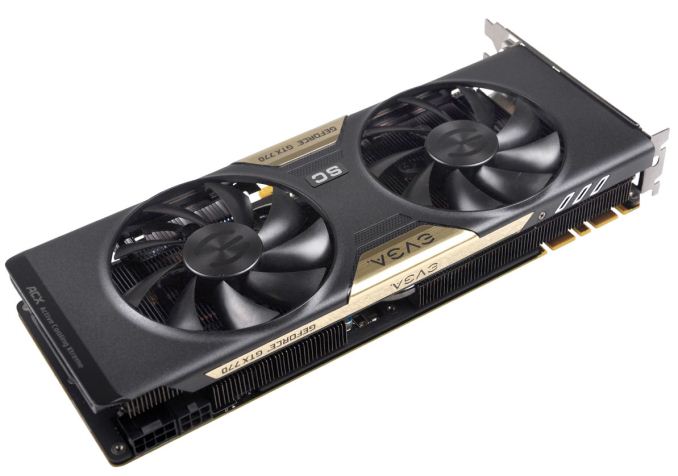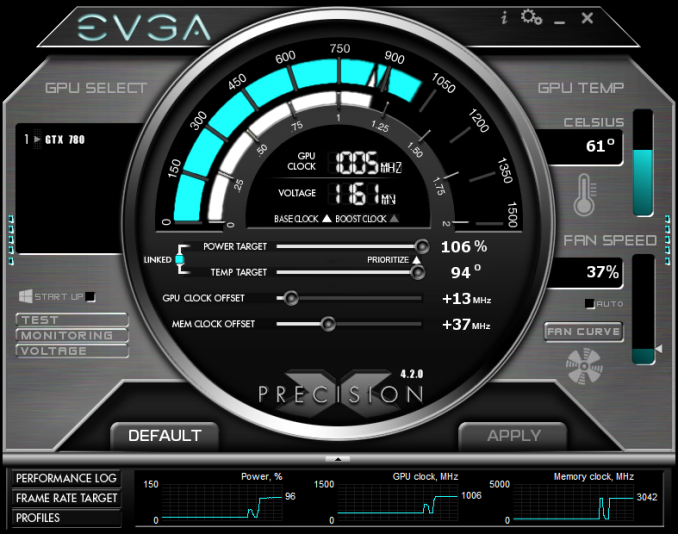The GeForce GTX 770 Roundup: EVGA, Gigabyte, and MSI Compared
by Ryan Smith on October 4, 2013 9:00 AM EST
Although it admittedly sounds derogatory at first, “small and unassuming” has become a good way to describe NVIDIA’s GK104 GPU. Unlike in past generations where NVIDIA’s high-end workhorse and flagship GPU were one in the same, for most of the lifespan of Kepler it has been GK104, not GK110, that has been the company’s high-end workhorse, being used in products spanning from $200 cards to $500 cards. At under 300mm2, GK104 products have proven capable of beating and/or tying AMD’s contemporary (and comparably more complex) products, which although a very good outcome for NVIDIA is certainly not the one we would have expected going into this generation.
At the same time however, GK104 being NVIDIA’s high-end workhorse has led to some unusual outcomes as NVIDIA attempts to pace themselves over the complete generation. Rather than scale down the more expensive GK110 GPU and its assorted products, NVIDIA has scaled up GK104 to keep their product lines fresh while continuing to hold off AMD, which is something they’ve never done before in this manner. This is especially evident in GeForce GTX 770, a very potent product that has seen NVIDIA release the first video card with 7GHz GDDR5, while in the process sacrificing some of their hard earned efficiency gains to reach their lofty performance goals. As a result of this GTX 770 is a product that is being pushed close to its limits right out of the box.
We bring this issue up because when it comes time to talk about custom vendor cards – as we’ll be doing today – it puts NVIDIA’s partners in an interesting and somewhat difficult position. Partners typically set their products apart by a combination of coolers, factory overclocking, and value added extras such as software and support. With NVIDIA pushing GTX 770 so hard partners aren’t getting access to the same lofty headroom that they enjoy in other products (e.g. GTX 780), which means GTX 770 ends up being a bit more constricting for the partners. To be sure there’s still room for them to maneuver on the clockspeed front, but when it comes to customizing GTX 770 a factory overclock isn’t going to make as much of an impact here.
With that in mind, today we’ll be looking at three such customized GTX 770 cards, from EVGA, Gigabyte, and MSI. All of these are semi-custom and fully custom cards pairing factory overclocks with custom coolers and custom software, so all three vendors are playing all three angles. How do these three partners set apart their products, especially in light of the constraints we just mentioned? Let’s find out.
| GeForce GTX 770 Specification Comparison | ||||||
| GeForce GTX 770 (Ref) | EVGA GTX 770 Superclocked ACX | Gigabyte GTX 770 OC Windforce 3X | MSI GTX 770 Lightning | |||
| Base Clock | 1046MHz | 1111MHz | 1137MHz | 1150MHz | ||
| Boost Clock | 1085MHz | 1163MHz | 1189MHz | 1202MHz | ||
| Memory Clock | 7GHz | 7GHz | 7GHz | 7GHz | ||
| VRAM | 2GB | 2GB | 2GB | 2GB | ||
| TDP | 230W | 230W | 230W | 260W | ||
| Width | Double Slot | Double Slot | Double Slot | Double Slot | ||
| Length | 10.5" | 10.5" | 11" | 11" | ||
| Warranty | N/A | 3 Year | 3 Year | 2 / 3 Year | ||
| Price | $399 | $399 | $399 | $434 | ||
EVGA GeForce GTX 770 Superclocked ACX
Our first card for this roundup is EVGA’s GTX 770 Superclocked ACX. Like its bigger brother who we reviewed last month, the 770SC ACX is a less than typical product for EVGA. The card itself is a semi-custom card, utilizing NVIDIA’s reference board but replacing NVIDIA’s Titan-esque metal blower for EVGA’s new ACX cooler. All of this is then wrapped up with a moderate factory overclock that sees EVGA ship the card at 1111MHz core, 65MHz (6%) over the GTX 770 reference clockspeeds.
Like the 780SC ACX, the 770SC ACX marks the first time we’ve seen EVGA’s new ACX cooler in this category of product. The ACX cooler is a notable departure from the norm for EVGA, who previously did not seriously involve themselves in the branded custom cooler market. With the ACX cooler EVGA is not only looking to tap into that market, alongside the larger market for open air coolers, but the company is looking to make a name for themselves based on build quality of their cooler, something EVGA’s competitors don’t always invest as heavily in and/or call as much attention to.
At its most basic level, the ACX cooler is a typical dual fan open air cooler, as we’ve seen countless times from other manufacturers. This basic design is very effective in moving large amounts of heat for relatively little noise, making the usual tradeoff of moving some of the cooling workload onto the system’s chassis (and its larger, slower fans) rather than doing the work entirely on its own. In EVGA’s case they’re using larger than typical fans for a dual fan cooler, with the ACX cooler’s fans coming in at 90mm diameter.
Meanwhile everyone has their own slight variations in design here, with EVGA focusing on running a full length heatsink to maximize their heatseak surface area. The heatsink itself is a two segment heatsink with 5 aluminum heatpipes running between the segments and the GPU. An aluminum baseplate runs the length of the card below the heatsink, providing both rigidity for the card and cooling for the VRAM and discrete components.
As for EVGA’s quality angle, the company is paying specific attention to the fans on their ACX cooler, using a fan blade design they say is optimized for strength and weight, while driving those fans with a double ball bearing motor. Much like the basic double fan design, ball bearings aren’t a major innovation in this space, but they are inconsistently used, often going unmentioned or interchanged with traditional sleeve bearings from one generation to the next. Mechanically speaking, compared to sleeve bearings, ball bearings typically have greater longevity and a bit less noise under heavy load, in exchange for a bit more noise at idle, making them a good tradeoff for a high-end card. From a practical point of view the longer lifespan of ball bearings will be the greatest gain out of this, while any noise tradeoffs are secondary as the fan itself will usually be the greater factor.
Cooling and factory overclock aside, the 770SC ACX is otherwise standard for a GTX 770 card. The card runs 10.5 inches long for both the PCB itself and EVGA’s ACX cooler. I/O is also standard with NVIDIA’s display I/O configuration of 2x DL-DVI, 1x HDMI, and 1x DisplayPort 1.2. Even the official TDP is the same at 230W, requiring the standard 6pin + 8pin external PCIe power connectors, which will be unlike some of the other cards in our roundup.
Rounding out the package is EVGA’s usual collection of software and hardware accessories, including a pair of PCIe power adapters and a DVI to VGA adapter. As far as EVGA’s software goes there’s little to be said that we haven’t said before: EVGA still shares the gold standard for software, with their fantastic Precision X overclocking utility and their OC Scanner X artifact scanning utility. Despite being based on the same RivaTuner core as MSI’s Afterburner, Precision X has diverged from Afterburner a bit over time, but as far as base overclocking and monitoring functions are concerned Precision X is among the best. And EVGA’s OC Scanner X software is second to none.
Meanwhile, as with all of EVGA’s North American cards, the 770SC ACX comes with EVGA’s standard 3 year transferable warranty, with individual 2 or 7 year extensions available for purchase upon registration, which will also unlock access to EVGA’s step-up upgrade program. Finally, the MSRP on the card is $409, only $10 above the MSRP for the standard GTX 770. However with a $10 mail in rebate active as of the time this was written, it brings the card down to $399, the MSRP of the stock GTX 770. As a result the card is something of a no-brainer within EVGA’s lineup, as it leaves no reason to purchase a slower card. The mild performance gains from the factory overclock won’t burn up the chart, but it makes the stock GTX 770 sufficiently redundant in performance.




















55 Comments
View All Comments
Ryan Smith - Friday, October 4, 2013 - link
We're not setup to review open loop coolers. However the new testbed will be able to accommodate GPUs with closed loop coolers, such as the Asus Ares.Hrel - Friday, October 4, 2013 - link
I am just endlessly impressed with Gigabyte. The consistently offer a performance to value ratio that is either the best or among the best and they do so at very competitive prices even without discounts and sales. When their products do go on sale they're simply unbeatable. I can't wait to see them expand into more categories.Hrel - Friday, October 4, 2013 - link
Also, their reliability is flawless and their support is top notch.Anandtech, when are you going to update your comment section? We REALLY need more features. The ability to edit comments, notifications via email when people respond. These are BASIC things.
Edkiefer - Friday, October 4, 2013 - link
This is one time for MSI, it probably just pays to get MSI Gaming N770 TF 2GD5/OC model as you mention 770 are pushed to limit already . The MSI gaming N770 TF is same price as others 399$RadiclDreamer - Friday, October 4, 2013 - link
I've been waiting for some time for a review that includes the 4GB version as well, any chance of that happening?Kevin G - Friday, October 4, 2013 - link
8.2 Ghz is very impressive for a memory overclock. I'd love to see such speeds on Ttian or the R9 290x for the extra bandwidth. That'd get you 524 GB/s bandwidth on the R9 290x which should be very beneficial for 4k gaming. Of course this is wishful thinking as going with a wider bus often limits memory bus speeds, but one can dream right?The Von Matrices - Saturday, October 5, 2013 - link
The problem is that the wider you make the memory bus the harder it is to route the traces on the PCB to allow high-frequency operation. AMD is only shipping the R9 290X at around 5GHz memory, and you can bet that in order to save on costs they won't be using higher rated memory chips. It might take custom PCBs before different memory chips are used, and AMD isn't allowing vendors to customize the card at all at launch.hulu - Friday, October 4, 2013 - link
You can use MSI Afterburner on any AMD/NVidia based graphics card regardless of vendor. Only thing you lose by going non-MSI non-reference board (like the Gigabyte of this roundup), is voltage control, but that is limited on these GTX 700 series cards anyway.wsaenotsock - Friday, October 4, 2013 - link
Maybe I missed it, but where the hell is the test system's information, or did including that information go out of style..iTzSnypah - Friday, October 4, 2013 - link
I think that to truly test the effectiveness of each cooler the noise and temperature graphs should use the reference clocks.